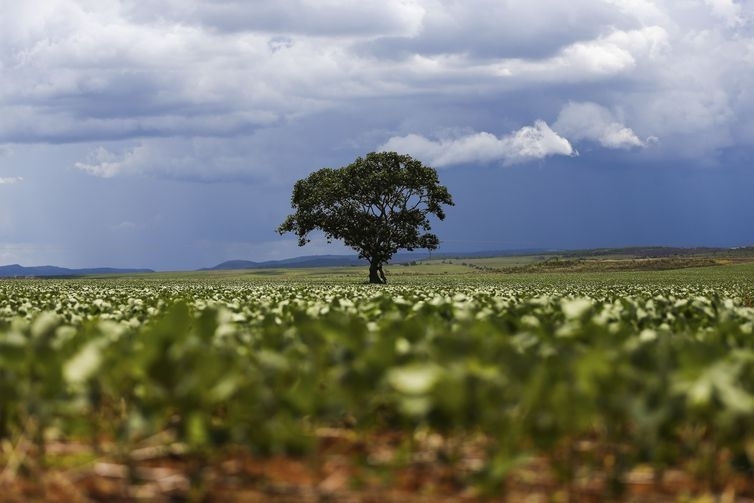


According to the article, Brazil has had more success than any other country with the use of biofertilizer to provide nitrogen for soybeans. The inoculation of microorganisms into the soil boosts yields, reduces greenhouse gas emissions and saves some USD 10 billion per year in imports of synthetic fertilizer (photo: Marcelo Camargo/Agência Brasil)
Published on 09/26/2022
By Maria Fernanda Ziegler | Agência FAPESP – Using biofertilizer on 80% of their planted area, Brazilian soybean growers are enjoying the environmental and economic benefits of employing the microbiome instead of chemical fertilizers. The microbiome is the community of fungi, bacteria and other microorganisms in a given environment. In farming, it provides the nutrients required by crops and boosts yields. Its use has many economic and environmental benefits.
The case of Brazilian soybeans is one of 14 success stories discussed in a review article on the impact of microbiome research on sectors such as agriculture, fermented products and human health. Published in Frontiers in Microbiology, it was undertaken as part of MicrobiomeSupport, a project funded by the European Union under its Horizon 2020 program to map global microbiome research, focusing on innovation in the food system.
The project involves scientists and companies in 28 countries, including the Genomics for Climate Change Research Center (GCCRC), one of the Engineering Research Centers (ERCs) supported by FAPESP. GCCRC is a partnership with the Brazilian Agricultural Research Corporation (EMBRAPA).
“Brazil is one of only a few countries in the world that successfully uses biofertilizer in soybean growing. It’s the largest producer and exporter of the commodity. Microorganisms are applied in order to fix nitrogen in 80% of the area planted with soybeans in Brazil. The positive environmental impact is very significant. Carbon emissions into the atmosphere are some 430 million tons of CO2 equivalent lower thanks to nitrogen-fixing bacteria. This also protects springs and other freshwater sources because chemical nitrogen contaminates rivers,” said Rafael de Souza, a co-author of the article. He is a researcher with GCCRC and a founder of Symbiomics, a Brazilian biotech startup that develops next-generation biologics.
Application of microorganisms to the soil also has a significant economic impact. “The war in Ukraine has shown how much we depend on imported chemical fertilizer,” Souza said. “Brazil imports some 77% of the nitrogen used to fertilize its farm crops. Soybeans are the only exception. They don’t depend on these imports precisely because of the biological nitrogen fixers used by growers, saving some USD 10 billion in synthetic nitrogen fertilizer.”
Biofertilizer saves farmers huge amounts of money. According to Solon Cordeiro de Araujo, a consultant to the National Association of Inoculant Producers and Importers (ANPII) and a co-author of the article, chemical fertilizer costs around BRL 1,000 per hectare while biofertilizer inoculants cost less than BRL 50 per hectare.
“The work done in the case of soybeans consists of selecting certain bacteria, isolating them and applying them to the crop in order to increase the quantity of these beneficial microorganisms in the soil. The bacteria replace synthetic nitrogen fertilizer. Instead of chemicals, farmers use biofertilizer inoculants, which take nitrogen from the air and feed it directly into the plant,” Araujo explained.
The impact is particularly important because Brazil is the world’s leading producer and exporters of soybeans, with more than 36 million hectares of planted area. The authors of the article highlight the economic and environmental benefits of microbiome research in Brazil in order to show growers of other crops the advantages of biofertilizer and to encourage scientists to do more research on the replacement of chemical fertilizer with microorganisms.
All crops require nitrogen, phosphorus and potassium. In the case of soybeans, biofertilizer supplies only nitrogen. The other two nutrients are supplied by chemicals. In other cases, such as corn, beans and rice, for example, all three nutrients are supplied by chemicals.
Nitrogen biofertilizer has been developed in Brazil since the introduction of soybeans in the 1960s. “Brazil opted for the development and refinement of these bacteria and bacterial products as substitutes for chemical nitrogen,” Araujo said.
According to the authors, substitution of chemical nitrogen by microbiome products in soybeans has been made possible by collaborative efforts in three areas. "This is the result of the work done in academia, regulation and industry. Scientists at universities and EMBRAPA brought the requisite technology to Brazil. Lawmakers passed the necessary regulatory framework. And industry has also played its part in terms of implementation and commercialization,” Souza said.
Research on microorganisms has been ongoing ever since soybean growing began in Brazil, but the number of articles and products has risen in the last ten years as genetic sequencing tools have become more accessible. “The case of Brazilian soybeans is also important because it paved the way for other products to gain market share and for other crops to use biofertilizer,” he added.
Model for other crops
The development of microbiome-based technologies is expected to expand in Brazil. Besides advances in research leading to better selection of microorganisms and production of more powerful inoculants, the researchers noted another series of factors that will contribute to the use of biofertilizer by growers of different crops.
“There’s talk of a perfect storm driving the use of biofertilizer in Brazil,” Souza said. “We now have a large number of startups and research centers interested in developing new microbiome products for different crops. The economic and environmental protection numbers are impressive. It’s also become clear that we need to rely less on chemical fertilizer, most of which is imported. The case of Brazilian soybeans could therefore be a driving force for further advances in the use of biofertilizer here.”
The article “Microbiome research as an effective driver of success stories in agrifood systems – A selection of case studies” (doi: 10.3389/fmicb.2022.834622) is at: www.frontiersin.org/articles/10.3389/fmicb.2022.834622/full.
Source: https://agencia.fapesp.br/39681